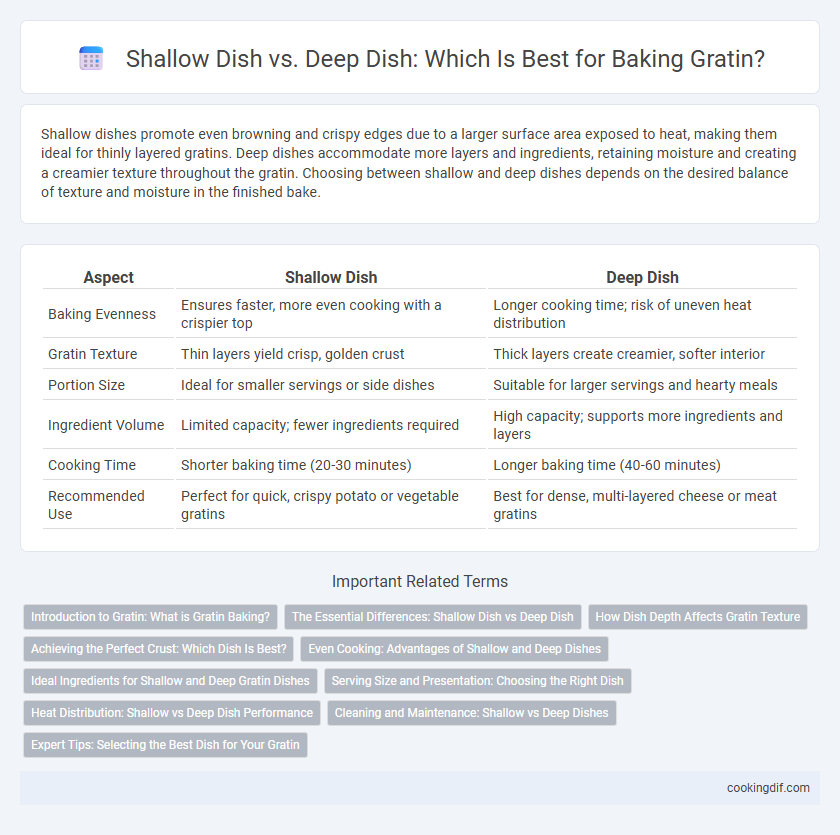Shallow dishes promote even browning and crispy edges due to a larger surface area exposed to heat, making them ideal for thinly layered gratins. Deep dishes accommodate more layers and ingredients, retaining moisture and creating a creamier texture throughout the gratin. Choosing between shallow and deep dishes depends on the desired balance of texture and moisture in the finished bake.
Table of Comparison
| Aspect | Shallow Dish | Deep Dish |
|---|---|---|
| Baking Evenness | Ensures faster, more even cooking with a crispier top | Longer cooking time; risk of uneven heat distribution |
| Gratin Texture | Thin layers yield crisp, golden crust | Thick layers create creamier, softer interior |
| Portion Size | Ideal for smaller servings or side dishes | Suitable for larger servings and hearty meals |
| Ingredient Volume | Limited capacity; fewer ingredients required | High capacity; supports more ingredients and layers |
| Cooking Time | Shorter baking time (20-30 minutes) | Longer baking time (40-60 minutes) |
| Recommended Use | Perfect for quick, crispy potato or vegetable gratins | Best for dense, multi-layered cheese or meat gratins |
Introduction to Gratin: What is Gratin Baking?
Gratin baking involves creating a dish with a browned crust, typically achieved by baking ingredients topped with cheese or breadcrumbs in an oven. Shallow dishes promote even browning and crispiness by allowing heat to circulate directly over the surface, ideal for lighter gratins. Deep dishes retain moisture and provide a creamier texture by holding more filling, suitable for heartier gratin recipes.
The Essential Differences: Shallow Dish vs Deep Dish
Shallow dishes promote faster baking and a crispier top layer in gratins due to greater surface area exposure, enhancing caramelization and browning. Deep dishes retain more moisture, resulting in a creamier interior but requiring longer cooking times to ensure even heat distribution. Choosing between shallow and deep dishes depends on desired texture and cooking duration, with shallow ideal for crisp texture and deep suitable for rich, tender gratins.
How Dish Depth Affects Gratin Texture
Shallow dishes promote faster evaporation, resulting in a crispier, golden-brown crust on gratin dishes due to less moisture retention. Deep dishes hold more liquid, producing a creamier texture with a softer, more tender interior as the heat distributes evenly throughout the thicker layers. Choosing dish depth directly influences the balance between crunchy top layers and moist, tender insides in gratin recipes.
Achieving the Perfect Crust: Which Dish Is Best?
Shallow dishes promote faster evaporation of moisture, resulting in a crispier, golden crust essential for an authentic gratin texture. Deep dishes retain more moisture, producing a creamier interior but often sacrificing the desired crunchy top layer. For achieving the perfect contrast between a crispy crust and tender filling, shallow baking dishes are typically the best choice.
Even Cooking: Advantages of Shallow and Deep Dishes
Shallow dishes promote even heat distribution, allowing gratin ingredients to cook uniformly and develop a crisp, golden crust. Deep dishes provide better heat retention, ensuring the center of the gratin cooks thoroughly without drying out, ideal for layered or denser recipes. Choosing between shallow and deep gratin dishes depends on balancing crispy textures with moist, evenly heated interiors.
Ideal Ingredients for Shallow and Deep Gratin Dishes
Shallow gratin dishes are ideal for ingredients that benefit from even browning and quicker cooking times, such as thinly sliced potatoes, zucchini, or layered vegetables with cheese and cream. Deep gratin dishes suit heartier, thicker ingredients like chunky vegetables, meat, or dense root vegetables, allowing for extended cooking to ensure tenderness throughout. Choosing the correct dish depth enhances texture and flavor by optimizing heat distribution and moisture retention during baking.
Serving Size and Presentation: Choosing the Right Dish
Shallow dishes provide even browning and crispy edges essential for a visually appealing gratin presentation, making them ideal for smaller servings or individual portions. Deep dishes accommodate larger quantities and layered ingredients, perfect for family-style servings but may result in uneven cooking and less crispiness on top. Selecting the right dish based on serving size balances the gratin's texture and visual appeal, enhancing both taste and presentation.
Heat Distribution: Shallow vs Deep Dish Performance
Shallow dishes allow for more even heat distribution and faster cooking, ensuring a crispy, golden crust on gratins. Deep dishes retain heat longer but may cause uneven cooking, with the center potentially undercooked while the edges become overdone. Choosing between shallow and deep gratin dishes impacts texture and doneness by influencing how heat penetrates the layers.
Cleaning and Maintenance: Shallow vs Deep Dishes
Shallow dishes for gratin baking typically offer easier cleaning and maintenance due to their broadly accessible surfaces, reducing food residue buildup in corners. Deep dishes, while providing greater capacity, often require more thorough scrubbing as gratin ingredients can stick to harder-to-reach edges. Choosing between shallow and deep gratin dishes impacts cleaning efficiency based on the dish's shape and material composition.
Expert Tips: Selecting the Best Dish for Your Gratin
Choosing the right dish depth significantly impacts gratin texture and cooking time; shallow dishes promote faster, even browning and crispy edges, while deep dishes retain moisture and create a creamier interior. Experts recommend ceramic or glass materials for heat retention and uniform cooking, ensuring the gratin cooks thoroughly without burning. For recipes with multiple layers or thicker fillings, a deep dish is preferred to accommodate volume, whereas simple gratins benefit from shallow dishes for optimal caramelization.
Shallow dish vs Deep dish for baking gratin Infographic

 cookingdif.com
cookingdif.com